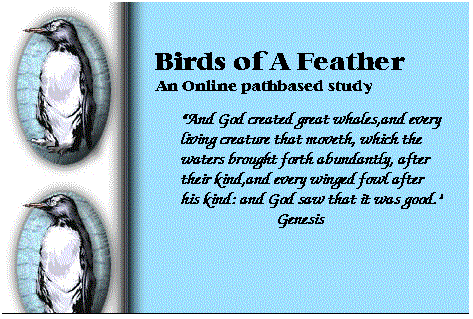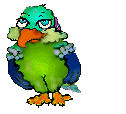

Link to Scenario |
Link to Student Pages |
Index of Projects |
Subject:
Science/Life Sciences;Language Arts/ Descriptive Writing; Math/ Number Skills
Grade Level: Grades 1-3
Abstract: Second graders and primary learning disabilities students is working on an integrated unit as part of the Chicago Academy of Science Museums in the Classroom Threatened, Endangered, and Extinct Species Program. Through this study students are introduce to the concept of plot studies.(The path study attempts to measure bird abundance over time and geographic area).
Learner Description/Environment: There are 18 second graders from various socioeconomic backgrounds; and 12 learning disabled students from grades first through third. Each of the two classrooms has a computer with internet access, scanner and the availability of a digital camera.
Time Frame:
Data should be collected twice a month from end of September to end of November
Rationale: The study of birds is one of the basic units of study in our life science curriculum in Oak Park. It is designed to focus on their characteristics, functions as well as how living things change.Birds are an ideal study because they are pretty, fun to watch and found in most every habitat, including urban environments. They also provide a fun way to explore science and study the environment around you.
Our goals are to have students observe and identify characteristics of birds. Students will also discover and investigate patterns in the type of bird populations they have found in their neighborhood and compare their results with classrooms across Illinois via the internet.
Learner Outcomes: Students will be able to:
Alignment with Standards: This project demonstrates elements of:
Structure of the Learning:
Content: Pose the Question: Have you ever noticed the birds in the trees or on the ground as you walk to school every day? Did you notice the different kinds there were, and how their numbers changed over time? If the answers to these questions are yes, then you have conducted a very basic path analysis of birds. All beginning scientist need to understand how to collect data in such a way that their information can be analyzed and compared to other data sites.This study will guide our students out into their environment to conduct their own path study on birds.By conducting these experiments we will be able to collect data that can be compared to data collected by classrooms across the state of Illinois.
Process: Our study is comprised of three sections:
In section 1 students are introduced to the general concepts of what birds are and how to identify types of birds. Students are placed in cooperative groups to search for answers on the internet, reference materials and CD ROMS. A Field guide will be constructed. (see A Closer look 1)
In section 2 students are involved in setting up their path.(The time spent setting up the path will also help us to determine habitats types and environment. ( see A Closer look 2 )
In section 3 This section encompasses the data collection and analysis of the project. Using our data and the technique of graphing, we will compare our results with classrooms across Illinois via the internet. (see A Closer look 3)
Product: Each student will make their own field guide; Students will use the internet for their research on birds. Hands on collaborative activities to integrate math, language arts and geography.
Student Assessment:
The students' final product, a field guide, will serve as the assessment. The book will have students own drawings of the birds found with brief facts included. The final project will also include a page summarizing their bird findings, including the kind of bird and where it was sighted. Assessment will be based on the drawings, how closely it resembles the real bird, and the facts the students can recall. (see Rubrics)
Project/Unit Evaluation:
This project will be evaluated by examining the information presented in their field guides. By looking at this information, one can easily see the number and variety of birds that were sighted.
 Enough With this
teacher stuff let's get to the kid's stuff!!! Just wait to you see what
we did!!!!!
Enough With this
teacher stuff let's get to the kid's stuff!!! Just wait to you see what
we did!!!!!
Created for the Fermilab LInC program sponsored by Fermi National Accelerator Laboratory Education Office, Friends of Fermilab, United States Department of Energy, Illinois State Board of Education, and North Central Regional Technology in Education Consortium which is operated by North Central Regional Educational Laboratory (NCREL). Author(s): Names of all authors (omiller@ameritect.net) School: Name of School, City, State Created: October 18, 1997 - Updated: October 18, 1997 URL: /lincon/f97projects/yourfolder/present.html